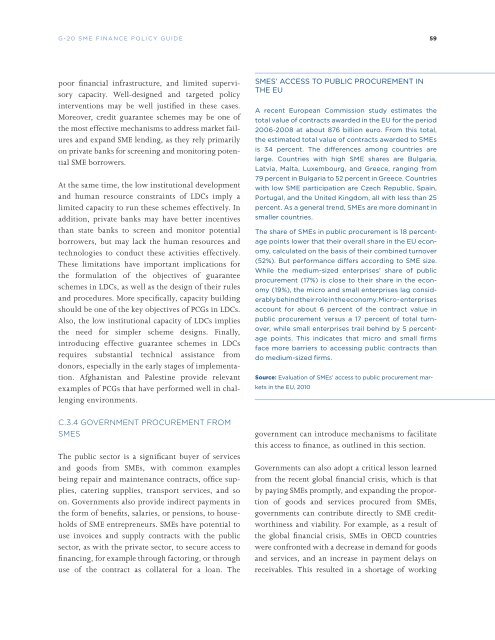SME Finance Policy Guide
SME Finance Policy Guide
SME Finance Policy Guide
Create successful ePaper yourself
Turn your PDF publications into a flip-book with our unique Google optimized e-Paper software.
G-20 <strong>SME</strong> FINANCE POLICY GUIDE<br />
59<br />
poor financial infrastructure, and limited supervisory<br />
capacity. Well-designed and targeted policy<br />
interventions may be well justified in these cases.<br />
Moreover, credit guarantee schemes may be one of<br />
the most effective mechanisms to address market failures<br />
and expand <strong>SME</strong> lending, as they rely primarily<br />
on private banks for screening and monitoring potential<br />
<strong>SME</strong> borrowers.<br />
At the same time, the low institutional development<br />
and human resource constraints of LDCs imply a<br />
limited capacity to run these schemes effectively. In<br />
addition, private banks may have better incentives<br />
than state banks to screen and monitor potential<br />
borrowers, but may lack the human resources and<br />
technologies to conduct these activities effectively.<br />
These limitations have important implications for<br />
the formulation of the objectives of guarantee<br />
schemes in LDCs, as well as the design of their rules<br />
and procedures. More specifically, capacity building<br />
should be one of the key objectives of PCGs in LDCs.<br />
Also, the low institutional capacity of LDCs implies<br />
the need for simpler scheme designs. Finally,<br />
introducing effective guarantee schemes in LDCs<br />
requires substantial technical assistance from<br />
donors, especially in the early stages of implementation.<br />
Afghanistan and Palestine provide relevant<br />
examples of PCGs that have performed well in challenging<br />
environments.<br />
<strong>SME</strong>s’ Access to Public Procurement in<br />
the EU<br />
A recent European Commission study estimates the<br />
total value of contracts awarded in the EU for the period<br />
2006-2008 at about 876 billion euro. From this total,<br />
the estimated total value of contracts awarded to <strong>SME</strong>s<br />
is 34 percent. The differences among countries are<br />
large. Countries with high <strong>SME</strong> shares are Bulgaria,<br />
Latvia, Malta, Luxembourg, and Greece, ranging from<br />
79 percent in Bulgaria to 52 percent in Greece. Countries<br />
with low <strong>SME</strong> participation are Czech Republic, Spain,<br />
Portugal, and the United Kingdom, all with less than 25<br />
percent. As a general trend, <strong>SME</strong>s are more dominant in<br />
smaller countries.<br />
The share of <strong>SME</strong>s in public procurement is 18 percentage<br />
points lower that their overall share in the EU economy,<br />
calculated on the basis of their combined turnover<br />
(52%). But performance differs according to <strong>SME</strong> size.<br />
While the medium-sized enterprises’ share of public<br />
procurement (17%) is close to their share in the economy<br />
(19%), the micro and small enterprises lag considerably<br />
behind their role in the economy. Micro- enterprises<br />
account for about 6 percent of the contract value in<br />
public procurement versus a 17 percent of total turnover,<br />
while small enterprises trail behind by 5 percentage<br />
points. This indicates that micro and small firms<br />
face more barriers to accessing public contracts than<br />
do medium-sized firms.<br />
Source: Evaluation of <strong>SME</strong>s’ access to public procurement markets<br />
in the EU, 2010<br />
C.3.4 GOVERNMENT PROCUREMENT FROM<br />
<strong>SME</strong>s<br />
The public sector is a significant buyer of services<br />
and goods from <strong>SME</strong>s, with common examples<br />
being repair and maintenance contracts, office supplies,<br />
catering supplies, transport services, and so<br />
on. Governments also provide indirect payments in<br />
the form of benefits, salaries, or pensions, to households<br />
of <strong>SME</strong> entrepreneurs. <strong>SME</strong>s have potential to<br />
use invoices and supply contracts with the public<br />
sector, as with the private sector, to secure access to<br />
financing, for example through factoring, or through<br />
use of the contract as collateral for a loan. The<br />
government can introduce mechanisms to facilitate<br />
this access to finance, as outlined in this section.<br />
Governments can also adopt a critical lesson learned<br />
from the recent global financial crisis, which is that<br />
by paying <strong>SME</strong>s promptly, and expanding the proportion<br />
of goods and services procured from <strong>SME</strong>s,<br />
governments can contribute directly to <strong>SME</strong> creditworthiness<br />
and viability. For example, as a result of<br />
the global financial crisis, <strong>SME</strong>s in OECD countries<br />
were confronted with a decrease in demand for goods<br />
and services, and an increase in payment delays on<br />
receivables. This resulted in a shortage of working














![Print a two-page fact sheet on this project [PDF] - IFC](https://img.yumpu.com/43449799/1/190x245/print-a-two-page-fact-sheet-on-this-project-pdf-ifc.jpg?quality=85)


